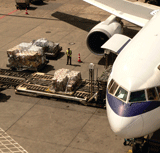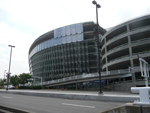
Fine Airport Parking in Tulsa, Okla., is much
more than just a parking facility.
- By Courtney Dillon Pedersen
- Mar 03, 2010

The Real ID Act is a federal law passed in 2005 that created new security, authentication and issuance standards for state driver's licenses and ID cards. Once the law is enacted, only cards that meet federal standards can be used for official purposes, as defined by the Department of Homeland Security, including boarding commercial airline flights and entering federal buildings and nuclear power plants.
- By Megan Weadock
- Mar 02, 2010
The Transportation Security Administration (TSA) announced recently that it is expanding the random use of Explosive Trace Detection (ETD) technology at airports nationwide as an additional layer of security.
Lincoln Park Airport is a 200 acre privately-owned public use airport located two miles north of Lincoln Park, N.J. With updated homeland security guidelines, the airport recently received state funding to obtain new security cameras.

Although passenger security is most often in the national spotlight, cargo security is just as important. That's why TSA mandated that 50 percent of all cargo carried aboard narrow-bodied passenger aircraft had to be screened for explosives by February 2009.
- By Megan Weadock
- Feb 03, 2010
Talk within the ranks of the security industry often focuses on air cargo security in regard to ground handling and transportation. There's good reason for concern, according to a report issued by the Office of the Inspector General within the Department of Homeland Security.
- By Ralph C. Jensen
- Feb 02, 2010
Remember 2005, when you could still board a plane with shampoo in your bag, toothpaste in your purse, a can of soda in your hand? Do those fluid memories hurt right down to your denture cream?
Vicon Industries Inc., a designer and producer of integrated IP video surveillance and access control systems, and SimplexGrinnell, a provider of fire and life-safety systems, have recently completed installation of an integrated video security system at Fairbanks International Airport in Alaska.
The Transportation Security Administration is still without a leader now that White House nominee Erroll Southers has withdrawn from consideration.
Pelco management recently announced that Addis Ababa Bole International Airport in Ethiopia -- Ethiopian Airport Enterprise (EAE) -- has chosen Pelco Inc. by Schneider Electric as the provider for its digital video recording.
A regional Midwest airport needed a way to automate gate security and deliver wireless video surveillance traffic from remote locations back to its monitoring stations. It had an inefficient and outdated system to protect the gates that consisted of access points that would require hands-on updates at each location every time there were personnel changes.
- By Paul Gassett
- Jan 11, 2010
Nearly half of American leisure travelers feel that airport passenger screening techniques are inadequate. In the national State of the American Traveler survey conducted this week by Destination Analysts, 47 percent of American leisure travelers reported they either "Agreed" or "Strongly agreed" that airport screening techniques were not sufficient. Only one-in-five travelers believe that passenger screening is adequate.

Several recent airport incidents have shown that technology alone will not provide proper security. One must consider personnel and security procedures as well.

Installing a deeply integrated security solution will provide the best security protection for airports of all sizes. The key to success lies in working with a manufacturer that partners with the security consultant, integrator and airport security manager to meet current and future requirements.
- By Kim Rahfaldt
- Jan 01, 2010
The Los Angeles World Airports (LAWA), the airport oversight and operations department for the City of Los Angeles, has awarded Unisys a security systems consultant contract to design and manage implementation of an integrated security environment for the organization’s three airports.
Smiths Detection recently announced Seattle-based Jetsream Freight Forwarding Inc. has purchased a HI-SCAN 100100T-2is X-ray system to meet Transportation Security Administration (TSA) air cargo screening mandates.
Department of Homeland Security Secretary Janet Napolitano recently announced the release of application guidance for the Transit Security Grant Program (TSGP) totaling an estimated $253 million -- funds for state, local and territorial governments and private sector entities to strengthen the nation’s transportation infrastructure and protect the traveling public from acts of terrorism and other major disasters.
Gemalto recently announced that it has surpassed 25 million smart card-based identity credentials shipped to the U.S. federal government.
The airline industry now has another well documented use for RFID -- baggage tracking.
Looking ahead to 2010, Unisys predicts that government and commercial organizations will take a more proactive approach to security, implementing new measures to verify identity and protect confidential information. Financial institutions and defense agencies will lead the charge, with ports and other organizations quickly following.
An agreement was announced recently between Los Angeles World Airports and the Transportation Security Administration (TSA) of the U.S. Department of Homeland Security which secured $150 million in federal funds for a key security project at Los Angeles International Airport.
L-3 Security & Detection Systems announced recently that the Transportation Security Administration has approved the ProVision active millimeter wave advanced imaging technology system for use in aviation checkpoints.

A new report by computer scientists at the National Institute of Standards and Technology demonstrates that iris recognition algorithms can maintain their accuracy and interoperability with compact images, affirming their potential for large-scale identity management applications.
While a majority (57 percent) of Homeland Security professionals say America is safer now than it was before the September 11 attacks, 75 percent believe the country will experience a similar terrorist attack in the next five years -- and Americans aren’t prepared, according to a recent survey commissioned by the National Homeland Defense Foundation and Colorado Technical University.
March Networks, a provider of intelligent IP video and business analysis applications, announced recently that the Australian Customs and Border Protection Service has selected the Company's VideoSphere solution to enhance its security operations in multiple airports across the country.
The Transportation Security Administration (TSA) has named Michael A. Scott as federal security director (FSD) for New York’s John F. Kennedy International Airport (JFK).
Genetec announced recently that Denver International Airport in Colorado has selected Omnicast, Genetec’s IP video surveillance solution, to secure their 53 square-mile facility. Ranked the 10th busiest airport in the world in 2008 for passenger traffic by Airport Council International, DIA officials were looking to upgrade an outdated analog system to a newer and more advanced network-based solution that they could evolve as newer technology emerged.

Airports exhibit one of the most complicated scenarios to administer restricted-area access control, identity verification and issuance of an access credential. Various airline employees, vendors, third-party contractors and tenants need to be authenticated at all times, and their physical access rights must be controlled and managed dynamically based upon their role and policies affecting their access.

Today's airports are as critical to homeland security as they were in the months following Sept. 11, 2001. Airport security officials have implemented new protocols and installed sophisticated scanning technology, while travelers have grown accustomed to more stringent security procedures— from removing shoes to the ubiquitous baggies of approved liquids.
Major airports typically have more than 1,000 cameras installed at and around their buildings and runways. Their security personnel often monitor facility perimeters with CCTV cameras as well, but these devices may be inadequate in truly keeping a close eye on potential risks.
- By Bob Banerjee
- Sep 01, 2009
The National Electrical Manufacturers Association (NEMA) has been selected by the U.S. Department of Homeland Security (DHS) to write a new standard for airport security. Called Digital Communication in Security (DICOS), the standard will enable the prevention, detection, and response to explosive attacks by standardizing the screening of checked bags and other threat risk detection attributes at airports and other security areas.

AMAG Technology and Entrance Controls will partner to provide a security management solution for Portland International Airport’s (PDX) new parking structure and office building. Port of Portland will install a Symmetry Homeland Security Edition System in the new structure which will consist of seven stories of parking space with an additional three top stories of Port office space. The new parking structure will triple PDX’s long-term parking capacity.
With the establishment of the TSA, airport security has grown in prominence as the most visible aspect within the realm of homeland security. In the United States, the checked baggage market is nearing critical mass, witnessing a slow decline. On the other hand, the checkpoint screening market is poised for steady growth due to increased focus and spending in this segment by TSA.
GVI Security Solutions, Inc., a provider of video security surveillance solutions featuring the complete Samsung Electronics line of products, announced that their Samsung Electronics cameras have been selected for an extensive, ongoing video surveillance upgrade and expansion project by a major United States based air freight operator.
The O.R. Tambo International Airport in Johannesburg, South Africa, is undergoing a major security project upgrade, adding to an existing DVTel video surveillance system already installed in the domestic and international terminals.

About 700 cargo containers, some weighing as much as 80,000 pounds, flow to and from the rail yard at the international marine terminal in Norfolk, Va., each day. In the months leading up to the Christmas season, that number can surge to more than 900 containers per day.
- By Fredrik Nilsson
- Jul 01, 2009

The Cayman Islands are a popular Caribbean getaway, so it’s not surprising that Owen Roberts International Airport is extremely busy for its size. Located on the southwest end of the largest island, Grand Cayman, the airport handles approximately 1 million passengers through its five boarding gates and facilitates 30,000 takeoffs and landings each year. The airport’s current 60,000-square-foot terminal has been welcoming passengers since 1985.
- By Anthony DeStefano
- Jun 24, 2009
Pivot3 recently announced that the Seattle-Tacoma International Airport selected Pivot3 Serverless Computing for a project that transitioned its highly critical surveillance environment from analog to digital while preserving the existing investment in analog cameras.
Prevailing international aviation rules mandate 100 percent screening for outbound carry-on baggage. Modern screening techniques involve X-ray or other imaging systems combined with chemical sniffers for scent or trace detection, physical search and permissible item restrictions. During the process of going through security, it is easy to associate a problem bag with its owner to resolve any violations.
- By Ashley Stephenson
- Jun 09, 2009
ADT Security has won the contract to provide the access control and video surveillance security systems to the new terminal 3 in Indira Gandhi International Airport, slated to open in March 2010.